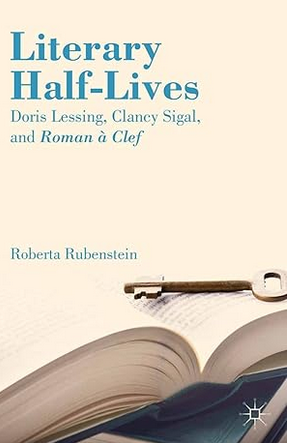Literary Half-Lives: Doris Lessing, Clancy Sigal, and Roman à Clef
- By Roberta Rubenstein
- Palgrave Macmillan
- 240 pp.
- Reviewed by Molly Lundquist
- November 3, 2014
An academic look at how one of literature’s giants mined her personal life for material.

“Writers in love can be hell on each other.” That remark, penned by Clancy Sigal in a 1998 review of newly released love letters from Simone de Beauvoir to Nelson Algren, could well have been written about his own affair with Doris Lessing 40 years earlier.
Sigal, a young American blacklisted from Hollywood, lived with Lessing in London from 1957-1960, the period in which Lessing was working on The Golden Notebook.
Lessing and Sigal were, apparently, “hell on each other.” Infidelity, jealousy, depression — the usual fault lines of relationships — were compounded by a byzantine literary cat-and-mouse game. The story of their affair, tortured and at times even comic, is recounted in Roberta Rubenstein’s Literary Half-Lives.
Rubenstein explores how both Lessing and Sigal made the other’s identity central to their works. In Lessing’s case, The Golden Notebook used a fictionalized version of Sigal as the love interest Saul Green; she also used Sigal as Dave Miller in "Play with a Tiger," her 1962 stage play.
Sigal waited longer to make use of Lessing, but he mined their relationship for the next 30 years. In his published and unpublished works, he gives as good as he gets; the result is some very funny writing.
While little of this is new ground, what is new is Rubenstein’s use of Sigal’s archives at the University of Texas, which have allowed her to uncover the extent of the writers’ mutual literary borrowing.
That borrowing — theft is the more apt word — has Lessing sneaking into Sigal’s room to read his journals, then transferring whole sections into The Golden Notebook. Once Sigal caught on, he planted silk thread as a detection device to determine when and how often she peeked.
Sigal then learned that Lessing was modeling a major character in her novel after him, and he began to alter his journal entries, knowing she would lift them.
Years later, Rubenstein tells us, Sigal “burnished the details for humorous effect.” He wrote that when Lessing left chapters in plain sight for him to find, he would “dash upstairs to scribble responses” in his journal, “which she’d then creep up to examine.” Lessing translated those responses “sometimes verbatim” to The Golden Notebook and left the updated manuscript lying around for Sigal, who would then dash back upstairs…and so on.
Despite the blatant fictionalizing of her affair with Sigal, Lessing always claimed that The Golden Notebook is not autobiographical. As Rubenstein points out, however, the fictional life of Anna Wulf, the novel’s protagonist, closely parallels Lessing’s own. And elsewhere, Lessing admitted that, yes, she did draw, as all authors do, upon her own life.
But Lessing and Sigal's writings go beyond “disguised autobiography.” Rubenstein posits that both writers wrote romans a clef — a genre that, while insisting on its own fiction, reveals “scandalous and often disturbing facts about real people and events.” Literally “novel with a key,” roman a clef is an authorial wink to those in the know, those who have the key to characters’ true identities.
While Sigal’s writings may indeed be romans a clef — he seemed to take obvious delight in making known his affair with Lessing — I think the case is not so clear when it comes to Lessing’s motivations. Was she intentionally revealing her affair with Sigal? Or was she transforming their relationship for strictly artistic purposes?
Finally, this must be said about Literary Half-Lives: It is a scholarly work. Most likely meant for those involved in literary research, it’s rough going for the lay reader. Tightly spaced text, academic jargon, and a somewhat confusing organization and repetitiveness make it a challenging read.
Granted, any discussion of The Golden Notebook, with its unusual structure and chronology, is difficult. But it becomes even more so when combined with the novels, plays, stories, unpublished journals, manuscripts, and typescripts of Clancy Sigal.
The Sigal material overlaps — both with itself and with Lessing’s work — and I found myself going back and forth, making copious margin notes, in an effort to keep track of the literary connections. A more insistent editor may have helped.
Nonetheless, Literary Half-Lives is a scrupulously researched and riveting account of two major literary talents whose mutual influence led to their “literary half-lives” in one another’s works.
Molly Lundquist owns and operates LitLovers, a website providing resources to book clubs and solo readers. Prior to founding LitLovers, she worked for 15 years as a public-relations speech writer. She later earned an M.A. in English and worked for several years as a college English instructor.

